GMC SIERRA 1993 Owners Manual
Manufacturer: GMC, Model Year: 1993, Model line: SIERRA, Model: GMC SIERRA 1993Pages: 436, PDF Size: 23.88 MB
Page 211 of 436
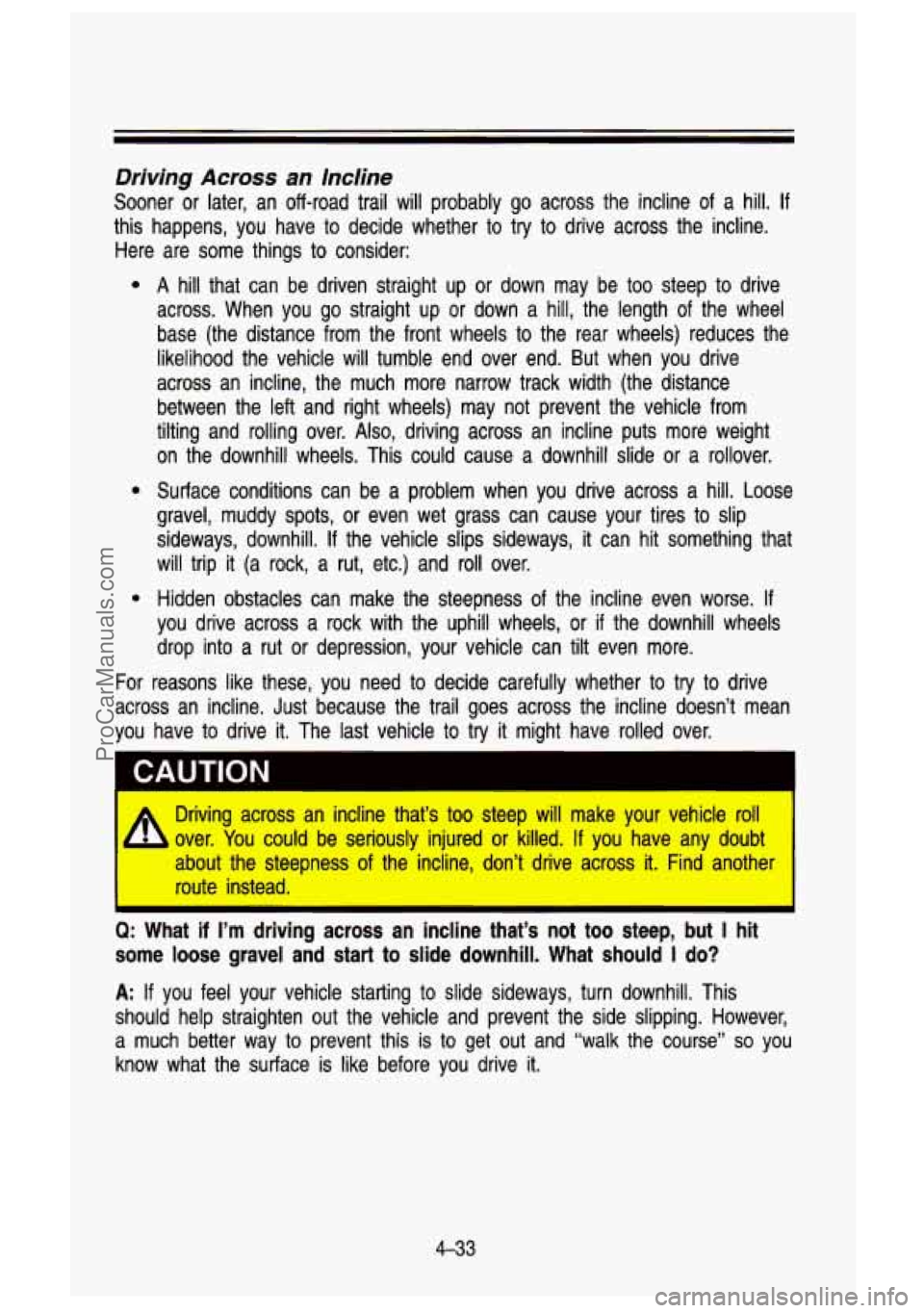
Driving Across an Incline
Sooner or later, an off-road trail will probably go across the incline of a hill. If
this happens, you have to decide whether to try to drive across the incline.
Here are some things to consider:
0
For
A hill that can be driven straight up or down may be too steep to drive
across. When you go straight up
or down a hill, the length of the wheel
base (the distance from the front wheels
to the rear wheels) reduces the
likelihood the vehicle will tumble end over end. But when you drive
across an incline, the much more narrow track width (the distance
between the left and right wheels) may not prevent the vehicle from
tilting and rolling over.
Also, driving across an incline puts more weight
on the downhill wheels. This could cause a downhill slide
or a rollover.
Surface conditions can be a problem when you drive across a hill. Loose
gravel, muddy spots,
or even wet grass can cause your tires to slip
sideways, downhill.
If the vehicle slips sideways, it can hit something that
will trip
it (a rock, a rut, etc.) and roll over.
Hidden obstacles can make the steepness
of the incline even worse. If
you drive across a rock with the uphill wheels, or if the downhill wheels
drop into a rut
or depression, your vehicle can tilt even more.
reasons like these, you need to decide carefully whether to try to drive
across an incline. Just because the trail goes across the incl\
ine doesn’t mean
you have to drive it. The last vehicle to try
it might have rolled over.
CAUTIP!
4 Driving across an incline that’s too steep will make your v\
ehicle roll
over. You could be seriously injured or killed. If you have any doubt
about the steepness
of the incline, don’t drive across it. Find another
route instead.
Q: What if I’m driving across an incline that’s not too steep, but I hit
some
loose gravel and start to slide downhill. What should I do?
A: If you feel your vehicle starting to slide sideways, turn downhill. This
should help straighten out the vehicle and prevent the side sl\
ipping. However,
a much better way to prevent this
is to get out and “walk the course” so you
know what the surface is like before you drive it.
4-33
ProCarManuals.com
Page 212 of 436
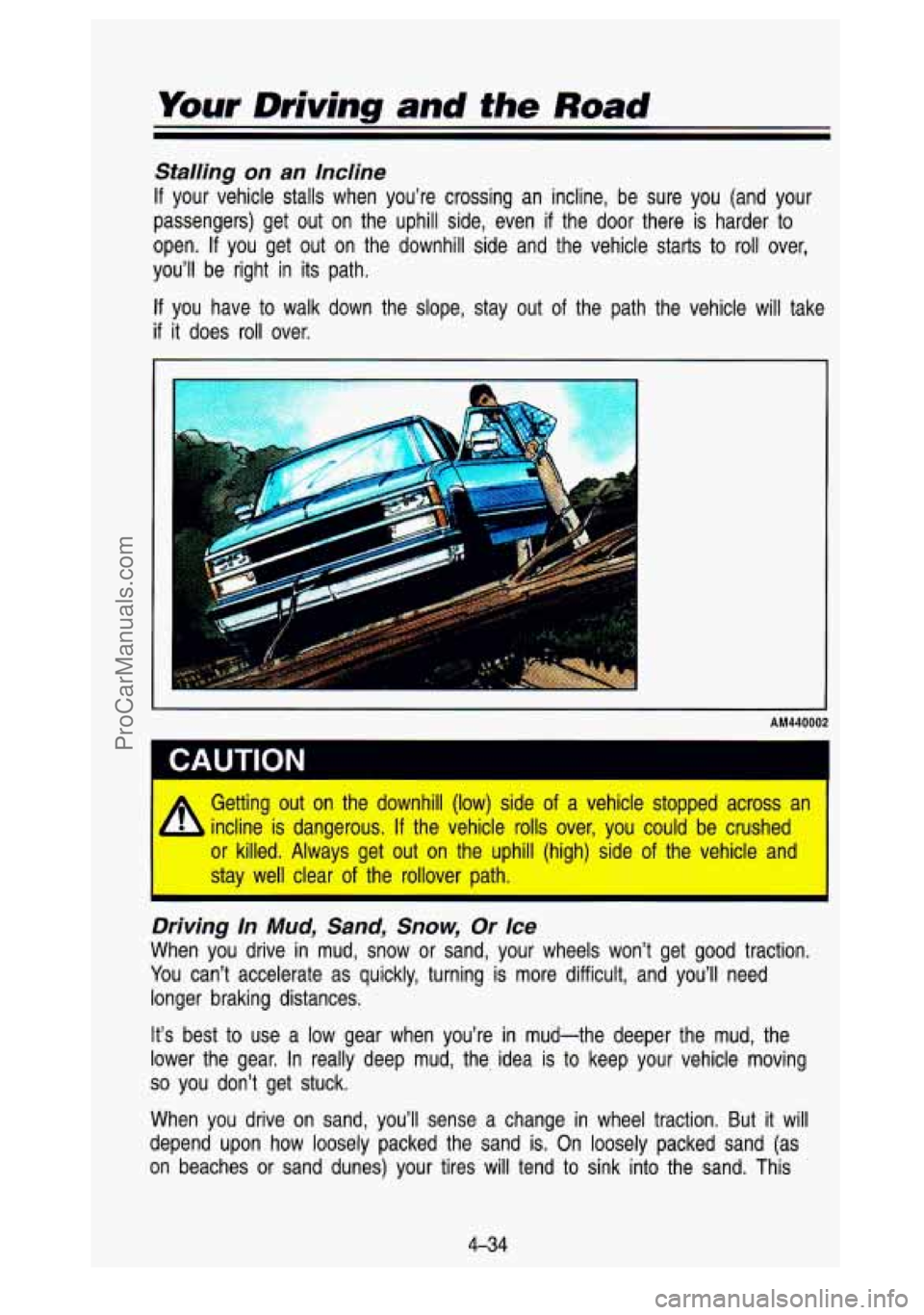
Your Driving and the Road
Stalling on an Incline
If your vehicle stalls when you’re crossing an incline, be sure you (and your
passengers) get out on the uphill side, even
if the door there is harder to
open. If you get out on the downhill side and the vehicle starts to roll over,
you’ll be right in its path.
If you have to walk down the slope, stay out of the path the vehicle will take
if ‘it does roll over.
AM440002
I CAUTION
A Getting out on the downhill (low) side of a vehicle stopped across an
incline is dangerous. If the vehicle rolls over, you could be \
crushed
or killed. Always get out on the uphill (high) side
of the vehicle and
I stay well clear of the rollover path.
Driving In Mud, Sand, Snow, Or Ice
When you drive in mud, snow or sand, your wheels won’t get good traction.
You can’t accelerate as quickly, turning
is more difficult, and you’ll need
longer braking distances.
It’s best
to use a low gear when you’re in mud-the deeper the mud, the
lower the gear. In really deep mud, the. idea is to keep you\
r vehicle moving
so you don’t get stuck.
When you drive
on sand, you’ll sense a change in wheel traction. But it will
depend upon how loosely packed the sand is. On loosely packed \
sand (as
on beaches or sand dunes) your tires will tend to sink into the sand. This
4-34
ProCarManuals.com
Page 213 of 436
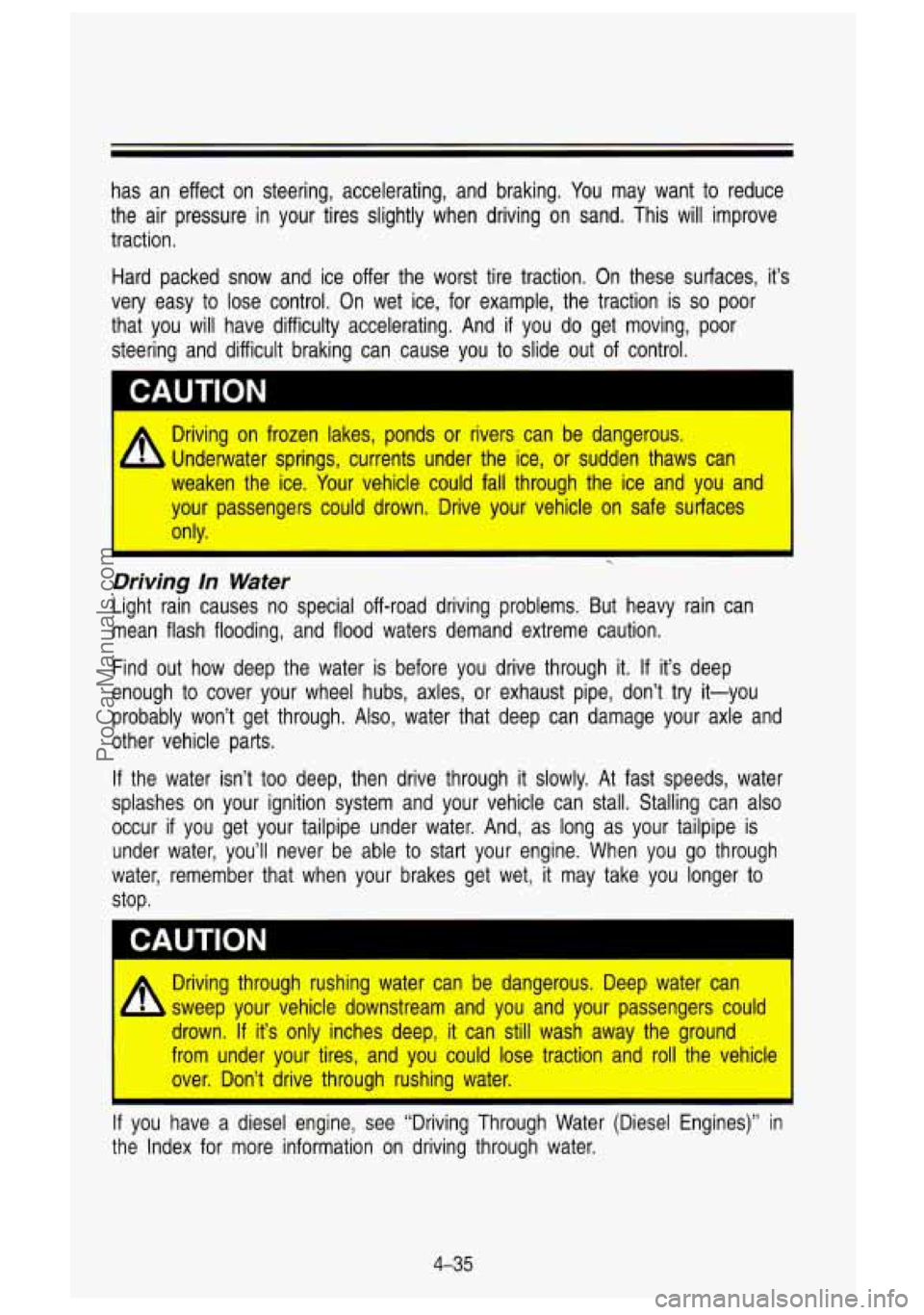
has an effect on steering, accelerating, and braking. You may want to reduce
the air pressure in your tires slightly when driving on sand. \
This will improve
traction.
Hard packed snow and ice offer the worst tire traction. On th\
ese surfaces, it’s
very easy to lose control. On wet ice, for example, the tract\
ion
is so poor
that you will have difficulty accelerating. And
if you do get moving, poor
steering and difficult braking can cause you to slide out of control.
I A Driving on frozen lakes, ponds or rivers can be dangerous. I
Underwater springs, currents under the ice, or sudden thaws can
weaken the ice. Your vehicle could fall through the ice and you and
your passengers could drown. Drive your vehicle on
safe surfaces
on
I y.
.
Driving In Water
Light rain causes no special off-road driving problems. But hea\
vy rain can
mean flash flooding, and flood waters demand extreme caution.
Find out how deep the water is before you drive through
it. If it’s deep
enough to cover your wheel hubs, axles, or exhaust pipe, don’\
t try it-you
probably won’t get through. Also, water that deep can damage\
your axle and
other vehicle parts.
If the water isn’t too deep, then drive through it slowly. At fast speeds, water
splashes on your ignition system and your vehicle can stall. S\
talling can also
occur
if you get your tailpipe under water. And, as long as your tailp\
ipe is
under water, you’ll never be able to start your engine. Whe\
n you go through
water, remember that when your brakes get wet, it may take you longer to
stop.
Driving through rushing water can be dangerous. Deep water can \
sweep your vehicle downstream and you and your passengers could\
drown.
If it’s only inches deep, it can still wash away the ground
from under your tires, and you could lose traction and roll t\
he vehicle
over. Don’t drive throuah rushina water. I
If you have a diesel engine, see “Driving Through Water (Diese\
l Engines)” in
the Index for more information on driving through water.
4-35
ProCarManuals.com
Page 214 of 436
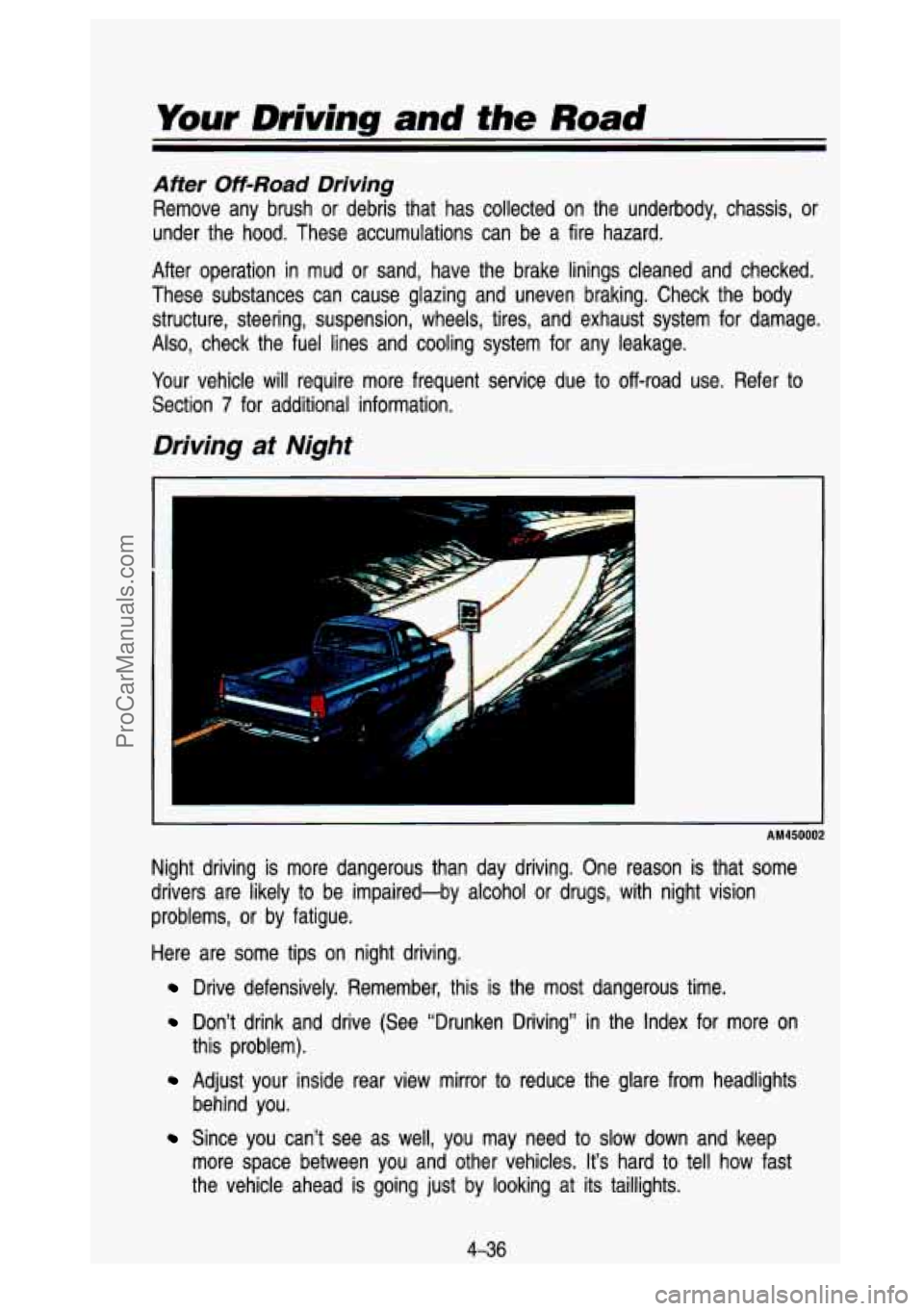
Your Driving and the Road
After Off-Road Driving
Remove any brush or debris that has collected on the underbody\
, chassis, or
under the hood. These accumulations can be a fire hazard.
After operation in mud or sand, have the brake linings cleaned\
and checked. These substances can cause glazing and uneven braking. Check th\
e body
structure, steering, suspension, wheels, tires, and exhaust syste\
m for damage.
Also, check the fuel lines and cooling system for any leakage.
Your vehicle will require more frequent service due
to off-road use. Refer to
Section
7 for additional information.
Driving at Night
I
--.
-
- AM450002 I
Night driving is more dangerous than day driving. One reason is that some
drivers are likely
to be impaired-by alcohol or drugs, with night vision
problems, or by fatigue.
Here are some tips on night driving.
Drive defensively. Remember, this is the most dangerous time.
Don’t drink and drive (See “Drunken Driving” in the Index for more on
this problem).
Adjust your inside rear view mirror to reduce the glare from headlights
Since you can’t see as well, you may need to slow down and keep
behind
you.
more space between you and other vehicles. It’s hard
to tell how fast
the vehicle ahead is going just
by looking at its taillights.
4-36
ProCarManuals.com
Page 215 of 436
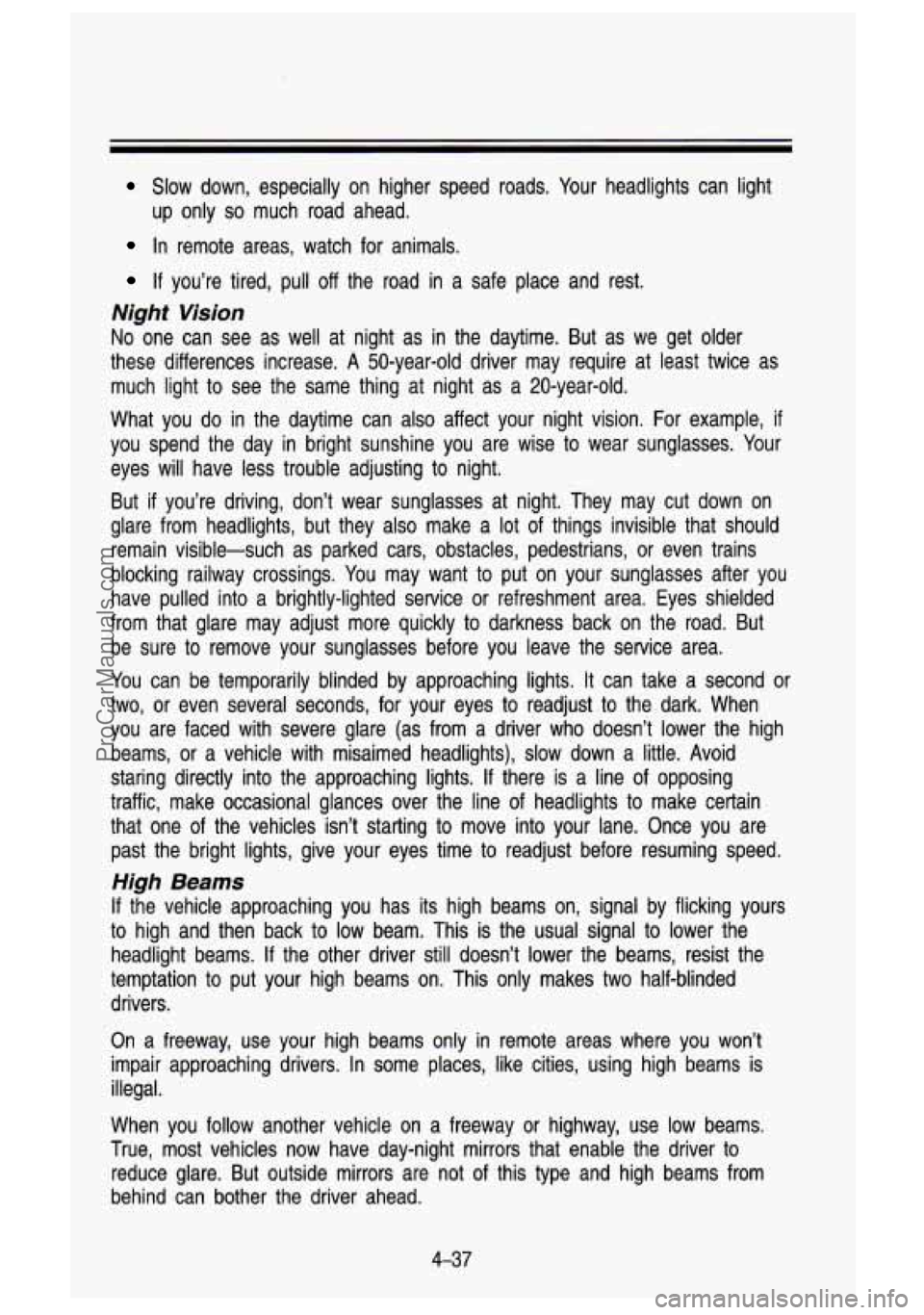
Slow down, especially on higher speed roads. Your headlights ca\
n light
In remote areas, watch for animals.
If you’re tired, pull off the road in a safe place and rest.
up only
so much road ahead.
Night Vision
No one can see as well at night as
in the daytime. But as we get older
these differences increase.
A 50-year-old driver may require at least twice as
much light to see the same thing at night as a 20-year-old.
What you do in the daytime can also affect your night vision.\
For example, if
you spend the day in bright sunshine you are wise to wear sunglasses. Your
eyes will have less trouble adjusting to night.
But if you’re driving, don’t wear sunglasses at night. Th\
ey may cut down on
glare from headlights, but they also make a lot of things inv\
isible that should
remain visible-such as parked cars, obstacles, pedestrians, or e\
ven trains
blocking railway crossings. You may want
to put on your sunglasses after you
have pulled into a brightly-lighted service or refreshment area.\
Eyes shielded
from that glare may adjust more quickly to darkness back on t\
he road. But
be sure to remove your sunglasses before you leave the service\
area.
You can be temporarily blinded by approaching lights.
It can take a second or
two, or even several seconds, for your eyes to readjust to the dark. When
you are faced with severe glare (as from a driver who doesn’\
t lower the high
beams, or a vehicle with misaimed headlights), slow down a little. Avoid\
staring directly into the approaching lights. If there is a line of opposing
traffic, make occasional glances over the line of headlights to make certain
that one of the vehicles isn’t starting to move into your lane. Once you are
past the bright lights, give your eyes time to readjust before\
resuming speed.
High Beams
If the vehicle approaching you has its high beams on, signal by \
flicking yours
to high and then back to low beam. This is the usual signal to lower the
headlight beams.
If the other driver still doesn’t lower the beams, resist the
temptation to put your high beams on. This only makes
two half-blinded
drivers.
On a freeway, use your high beams only in remote areas where \
you won’t impair approaching drivers. In some places, like cities, using \
high beams is
illegal.
When you follow another vehicle on a freeway or highway, use \
low beams.
True, most vehicles now have day-night mirrors that enable the \
driver to
reduce glare. But outside mirrors are not
of this type and high beams from
behind can bother the driver ahead.
4-37
ProCarManuals.com
Page 216 of 436
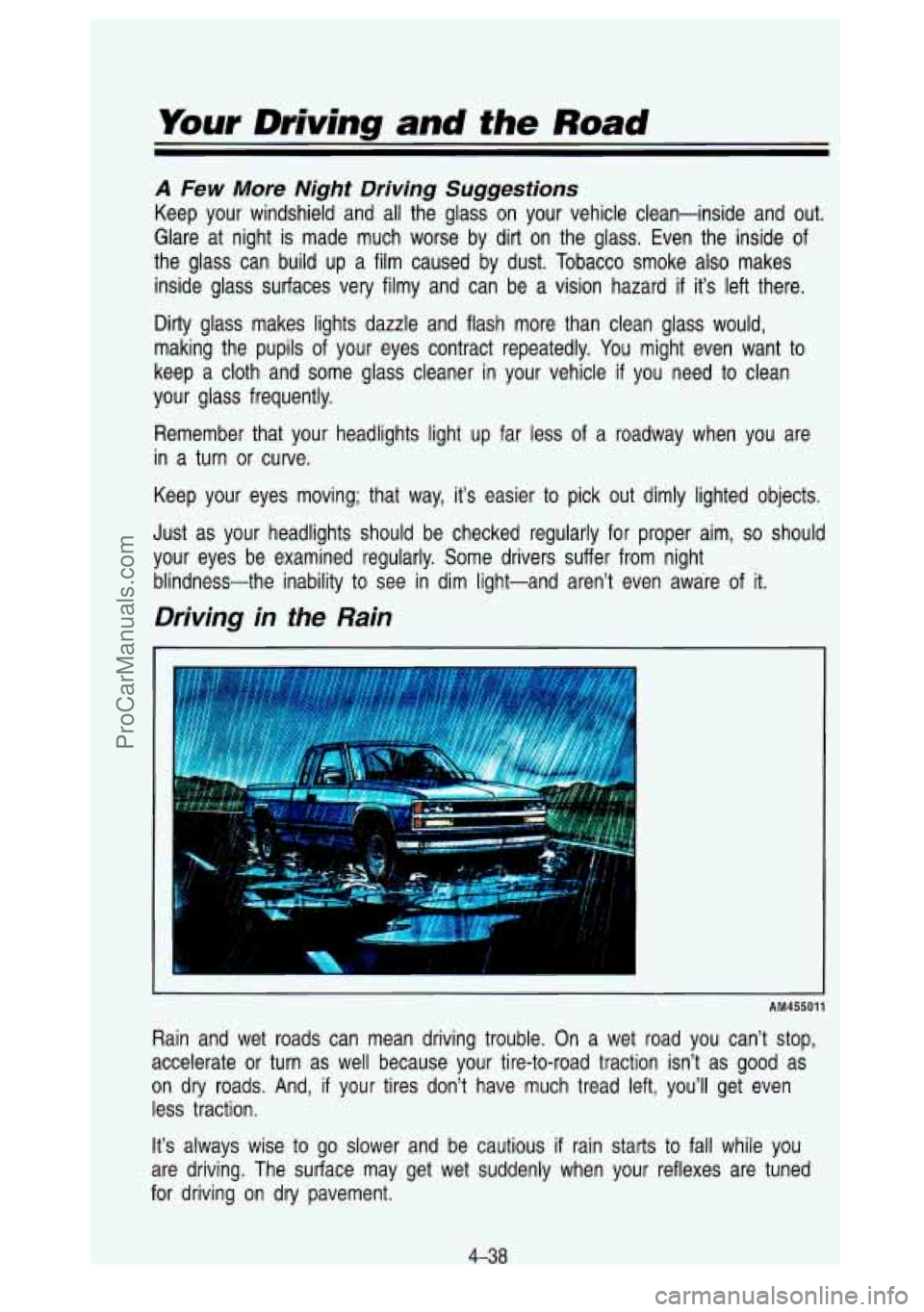
Your Driving and the Road
A Few More Night Driving Suggestions
Keep your windshield and all the glass on your vehicle clean-i\
nside and out.
Glare at night is made much worse by dirt on the glass. Even\
the inside
of
the glass can build up a film caused by dust. Tobacco smoke \
also makes inside glass surfaces very filmy and can be a vision hazard
if it’s left there.
Dirty glass makes lights dazzle and flash more than clean glas\
s would,
making the pupils of your eyes contract repeatedly. You might even want to
keep a cloth and some glass cleaner in your vehicle
if you need to clean
your glass frequently.
Remember that your headlights light up far less of a roadway \
when you are
in a turn or curve.
Keep your eyes moving; that way, it’s easier to pick out d\
imly lighted objects.
Just as your headlights should be checked regularly for proper \
aim,
so should
your eyes be examined regularly. Some drivers suffer from night\
blindness-the inability to see in dim light-and aren’t even aware of
it.
Driving in the Rain
Rain and wet roads can mean driving trouble. On a wet road y\
ou can’t stop,
accelerate or turn as well because your tire-to-road traction i\
sn’t as
good as
on
dry roads. And, if your tires don’t have much tread left, you’ll get even
less traction.
It’s always wise to go slower and be cautious if rain starts to fall while you
are driving. The surface may get wet suddenly when your reflex\
es are tuned
for driving on
dry pavement.
4-38
ProCarManuals.com
Page 217 of 436
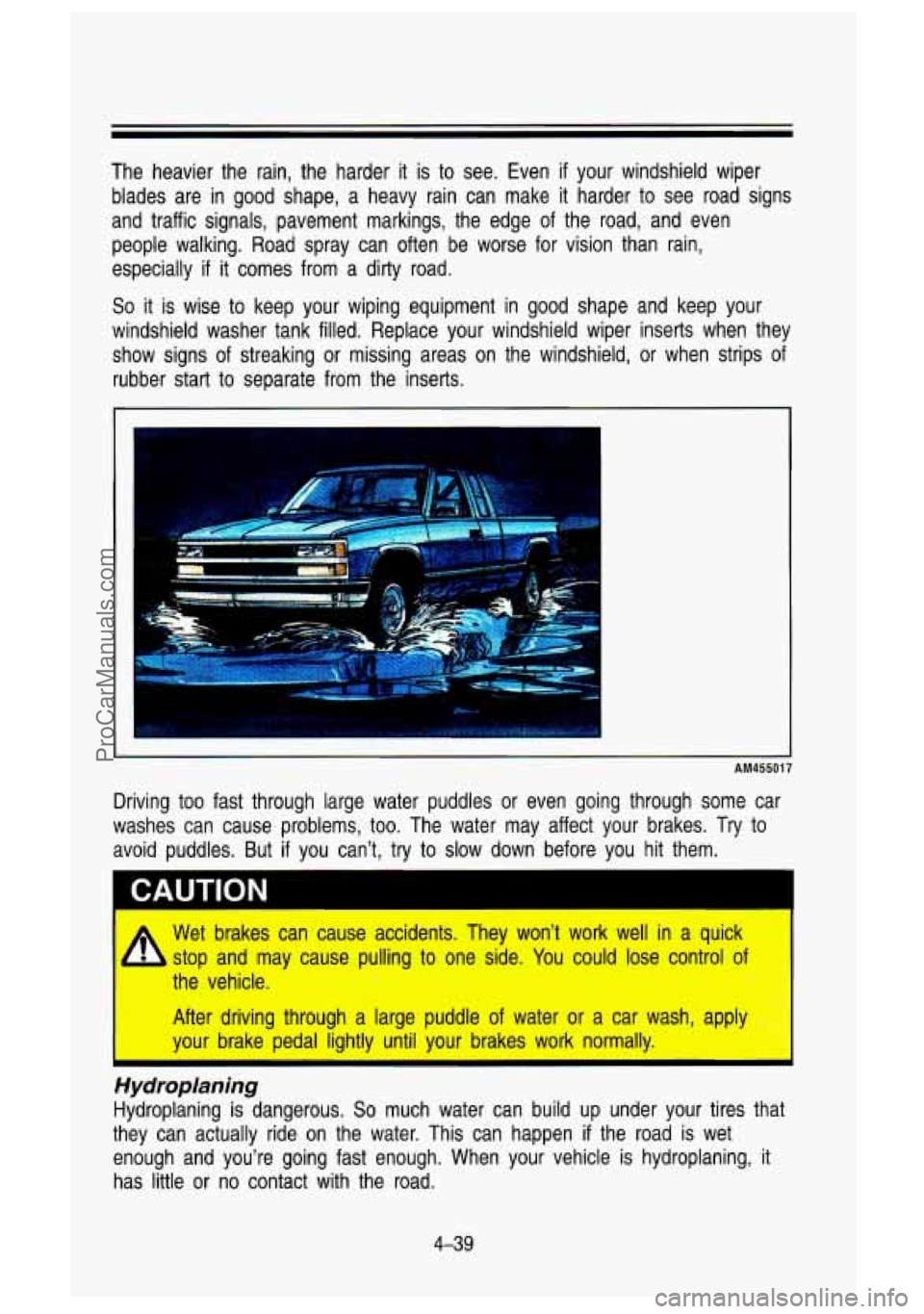
The heavier the rain, the harder it is to see. Even if your windshield wiper
blades are in good shape, a heavy rain can make it harder to see road signs
and traffic signals, pavement markings, the edge of the road, and even
people walking. Road spray can often be worse for vision than \
rain,
especially
if it comes from a dirty road.
So it is wise to keep your wiping equipment in good shape and keep you\
r
windshield washer tank filled. Replace your windshield wiper ins\
erts when they show signs of streaking or missing areas on the windshield,
or when strips of
rubber start
to separate from the inserts.
.
AM455017 4
Driving too fast through large water puddles or even going through some car
washes can cause problems,
too. The water may affect your brakes. Try to
avoid puddles. But
if you can't, try to slow down before you hit them.
Wet brakes can cause accidents. They won't work well in a quick
d stop and may cause pulling to one side. You could lose control of
the vehicle.
After driving through a large puddle of water or a car wash, apply
your brake pedal lightly until your brakes work normally.
Hydroplaning
Hydroplaning is dangerous. So much water can build up under your tires that
they can actually ride on the water. This can happen
if the road is wet
enough and you're going fast enough. When your vehicle is hydr\
oplaning,
it
has little or no contact with the road.
4-39
ProCarManuals.com
Page 218 of 436
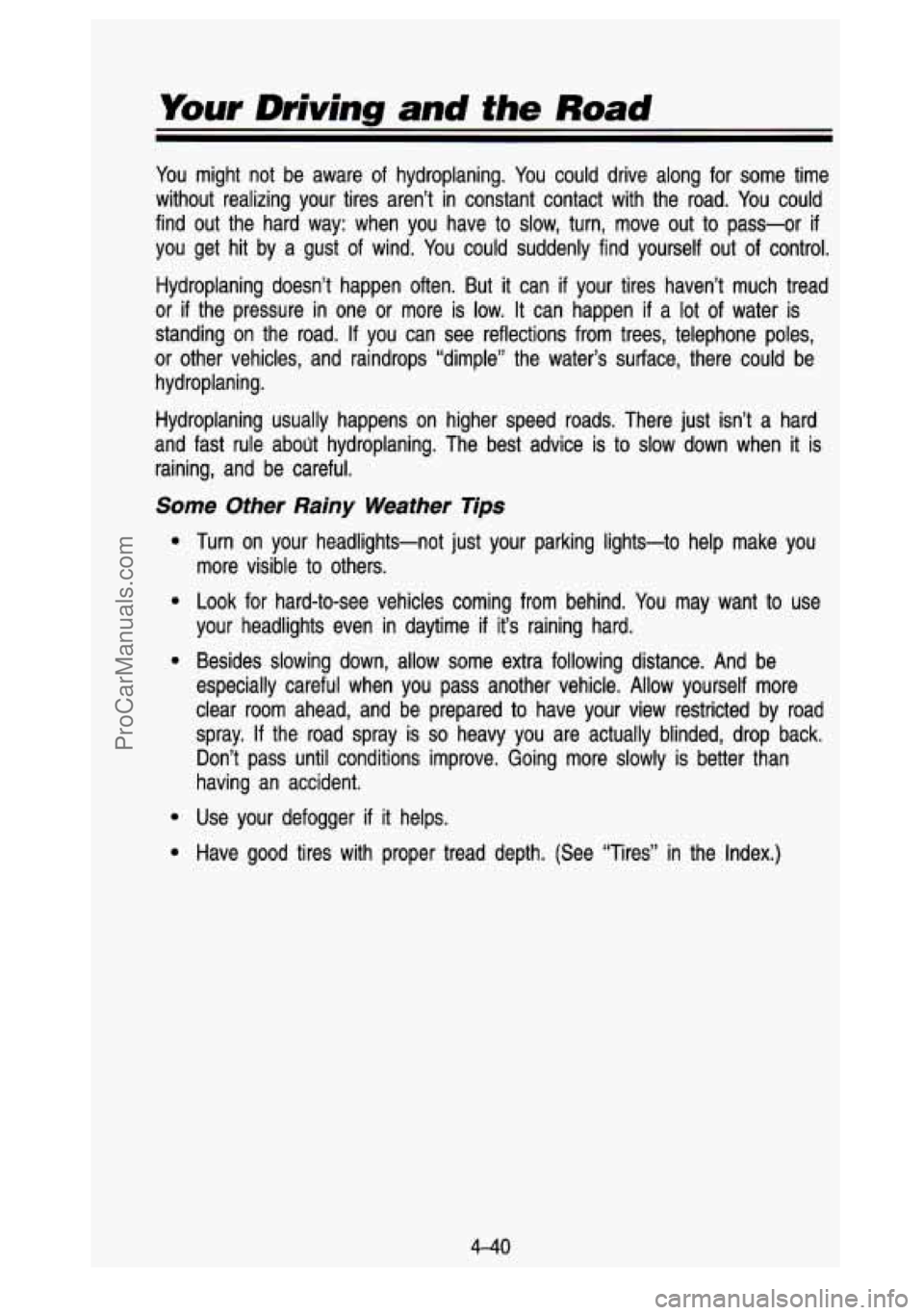
Your Driving and the Road
You might not be aware of hydroplaning. You could drive along for some time
without realizing your tires aren’t in constant contact with \
the road. You could
find out the hard way: when you have to slow, turn, move out to pass-or
if
you get hit by a gust of wind. You could suddenly find yourself out of control.
Hydroplaning doesn’t happen often. But it can
if your tires haven’t much tread
or if the pressure in one or more is low. It can happen if a lot of water is
standing
on the road. If you can see reflections from trees, telephone poles,
or other vehicles, and raindrops “dimple” the water’s surfa\
ce, there could be
hydroplaning.
Hydroplaning usually happens on higher speed roads. There just \
isn’t a hard
and fast rule about hydroplaning. The best advice is to slow \
down when it is
raining, and be careful.
Some Other Rainy Weather Tips
e
e
e
e
e
Turn on your headlights-not just your parking lights-to help ma\
ke you more visible to others.
Look for hard-to-see vehicles coming from behind. You may want to use
your headlights even in daytime
if it’s raining hard.
Besides slowing down, allow some extra following distance. And \
be
especially careful when you pass another vehicle.
Allow yourself more
clear
room ahead, and be prepared to have your view restricted by road
spray.
If the road spray is so heavy you are actually blinded, drop back.
Don’t pass until conditions improve. Going more slowly is be\
tter than
having an accident.
Use your defogger
if it helps.
Have good tires with proper tread depth. (See “Tires” in\
the Index.)
4-40
ProCarManuals.com
Page 219 of 436
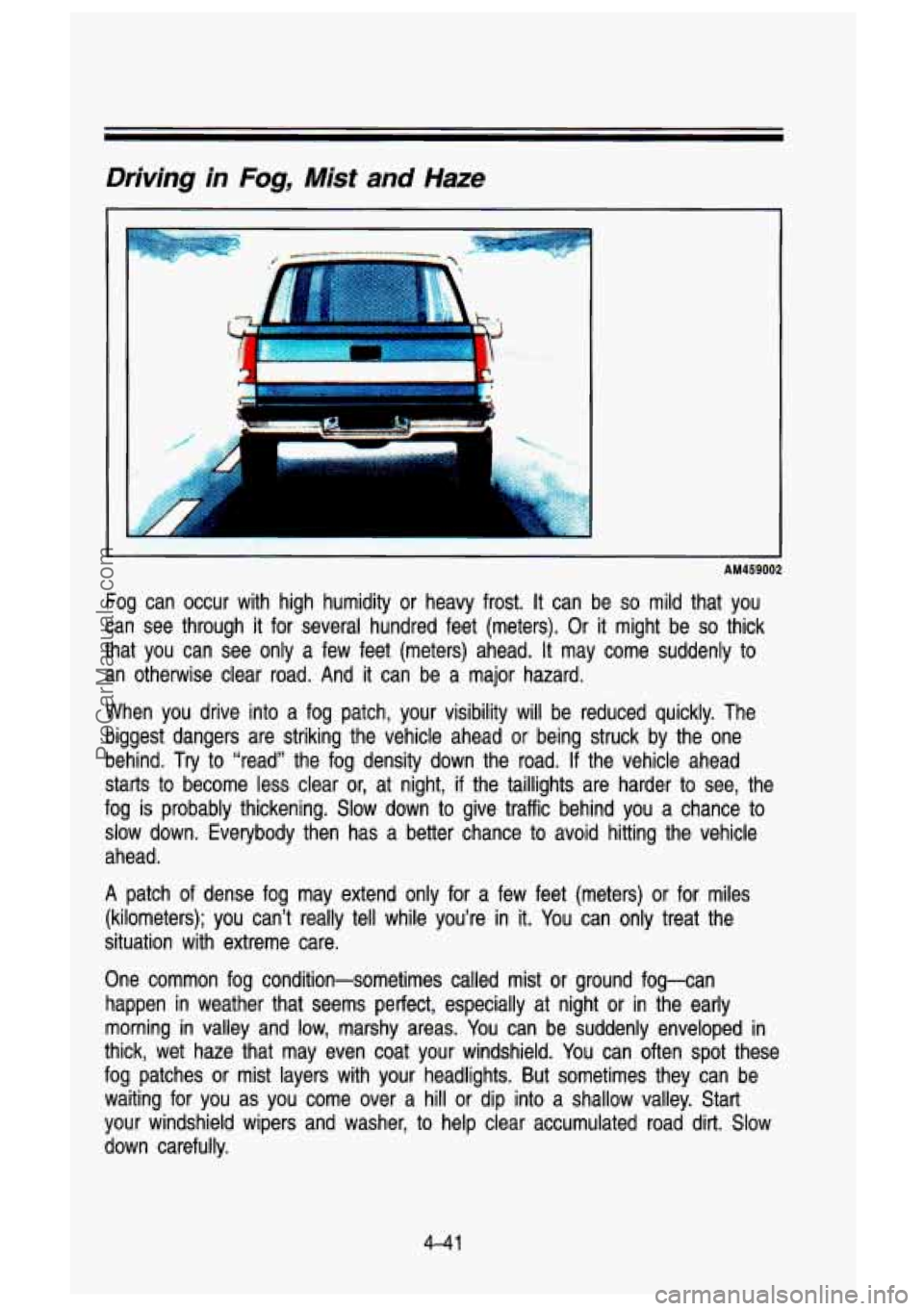
Driving in Fog, Mist and Haze
AM459002
Fog can occur with high humidity or heavy frost. It can be so mild that you
can see through it for several hundred feet (meters). Or it might be
so thick
that you can see only a few feet (meters) ahead.
It may come suddenly to
an otherwise clear road. And it can be a major hazard.
When you drive into a fog patch, your visibility will be reduced quickly. The
biggest dangers are striking the vehicle ahead or being struck \
by the one
behind.
Try to “read” the fog density down the road. If the vehicle ahead
starts to become
less clear or, at night, if the taillights are harder to see, the
fog is probably thickening. Slow down to give traffic behind you a chance to
slow down. Everybody then has a better chance to avoid hitting the vehicle
ahead.
A patch of dense fog may extend only for a few feet (meters) or for miles
(kilometers); you can’t really tell while you’re in it. You can only treat the
situation with extreme care.
One common fog condition-sometimes called mist or ground fog-can
happen in weather that seems perfect, especially at night or i\
n the early
morning
in valley and low, marshy areas. You can be suddenly enveloped in
thick, wet haze that may even coat your windshield. You can often spot t\
hese
fog patches or mist layers with your headlights. But sometimes \
they can be waiting for you as you come over a hill or dip into a shallow valley. Start
your windshield wipers and washer, to help clear accumulated ro\
ad dirt.
Slow
down carefully.
4-41
ProCarManuals.com
Page 220 of 436
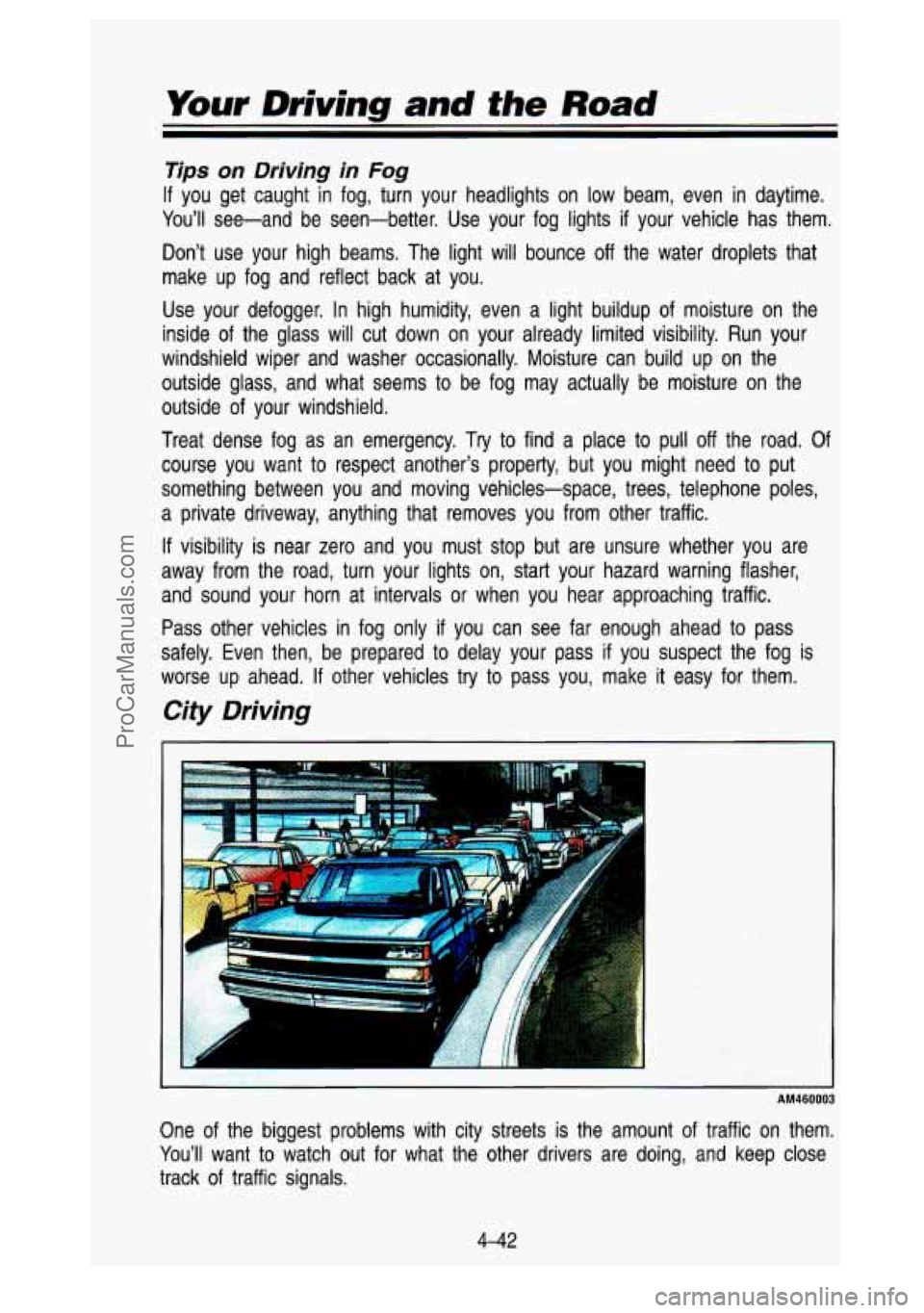
Your Driving and the Road
Tips on Driving in Fog
If you get caught in fog, turn your headlights on low beam, \
even in daytime.
You’ll see-and be seen-better. Use your fog lights
if your vehicle has them.
Don’t use your high beams. The light will bounce
off the water droplets that
make up fog and reflect back at you.
Use your defogger. In high humidity, even a light buildup of moisture on the
inside of the glass will cut down on your already limited visibility. Ru\
n your
windshield wiper and washer occasionally. Moisture can build up on the
outside glass, and what seems to be
fog may actually be moisture on the
outside of your windshield.
Treat dense fog as an emergency.
Try to find a place to pull off the road. Of
course you want to respect another’s property, but you might need to put
something between you and moving vehicles-space, trees, telephone\
poles,
a private driveway, anything that removes you from other traffic.
If visibility is near zero and you must stop but are unsure whether you are
away from the road, turn your lights on, start your hazard wa\
rning flasher,
and sound your horn at intervals or when you hear approaching \
traffic.
Pass other vehicles in fog only
if you can see far enough ahead to pass
safely. Even then, be prepared to delay your pass
if you suspect the fog is
worse up ahead. If other vehicles try to pass you, make it easy for them.
City Driving
AM460003
One of the biggest problems with city streets is the amount of traffic on them.
You’ll want to watch out for what the other drivers are doing, and keep clos\
e
track
of traffic signals.
4-42
ProCarManuals.com